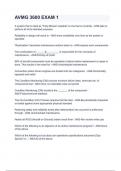Summary
Adolescence 13th edition summary for first exam
- Course
- Institution
Adolescence 13th edition summary for first exam. Chapters for the first exam are summarized: Introduction, chapter 3, 8, 1, 2 and partially 9. In English. Adolescent development course.
[Show more]




